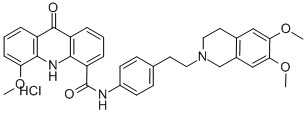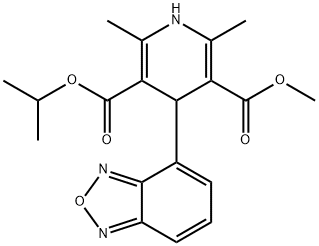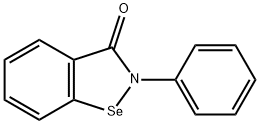Elacridar
Synonym(s):GF120918;GG918;GW0918;N-[4-[2-(3,4-Dihydro-6,7-dimethoxy-2(1H)-isoquinolinyl)ethyl]phenyl]-9,10-dihydro-5-methoxy-9-oxo-4-acridinecarboxamide
- CAS NO.:143664-11-3
- Empirical Formula: C34H33N3O5
- Molecular Weight: 563.64
- MDL number: MFCD00912604
- EINECS: 1532714-185-1
- SAFETY DATA SHEET (SDS)
- Update Date: 2024-11-19 23:02:33

What is Elacridar?
Chemical properties
Yellow Solid
The Uses of Elacridar
Elacridar has been used:
- as a chemical to decipher the link between autophagy and the mechanism of resistance to sunitinib
- as an ATP-binding cassette sub-family B member 1 inhibitor to study its effects on the NSC23766 cytotoxicity
- to treat rhodamine 123 (Rh123) labeled cells to set sorting gates in fluorescence-activated cell sorting (FACS)
The Uses of Elacridar
A prototypical BCRP inhibitor. Inhibits the Bcrp1-mediated transport.
What are the applications of Application
Elacridar is a prototypical BCRP (ABCG2) inhibitor
Biological Activity
elacridar is a potent inhibitor of p-glycoprotein with ic50 values of 193 nm. [1]p-glycoprotein (permeability glycoprotein) is an important membrane protein. it pumps many foreign substances out of cells. p-glycoprotein belongs to the mdr/tap subfamily. p-glycoprotein is transmembrane glycoprotein which is about 170 kda. it is expressed in certain cell types primarily in the pancreas, liver, colon and kidney. it contains 6 transmembrane domains in the n-terminal half of the molecule. it also contains an atp-binding site in the large cytoplasmic domain. p-glycoprotein binds to the substrate at the cytoplasmic side of the protein. when atp binds to the cytoplasmic side, the substrate was excreted from the cell. p-glycoprotein can pump toxins or drugs back into the intestinal lumen, pumps them into bile ducts in liver cells.in some cancer cells, p-glycoprotein is overexpressed. it is involved in multidrug resistance of cancer cells.[2]elacridar can significantly inhibit the activity of p-glycoprotein at 1μm in mdckii cells which overexpress p-glycoprotein.[3] in the parental mdck-ii cells, elacridar at 5μm completely inhibit the polarized sunitinib transport.[4] elacridar did not inhibit the activity of several human cytochromep450 enzymes in vitro. the absolute bioavailability was about 0.47 and 1.3 respectively, when elacridar was given in the orally and microemulsion, intraperitoneally at 10 mg/kg in mice.[3] elacridar also can significantly increase sunitinib brain accumulation levels in mice at 10 mg/kg.[4]
Biochem/physiol Actions
GF120918 (Elacridar) is a very potent inhibitor of the ABC transporters MDR-1 (P-gp) and BCRP. GF120918 increases the bioavailability of cytotoxic anti-tumor drugs, and also leads to increased levels of anti-HIV drugs in the brain and CNS.
References
[1]. bankstahl jp, bankstahl m, romermann k, wanek t, stanek j, windhorst ad, fedrowitz m, erker t, muller m, loscher w et al: tariquidar and elacridar are dose-dependently transported by p-glycoprotein and bcrp at the blood-brain barrier: a small-animal positron emission tomography and in vitro study. drug metab dispos, 41(4):754-762.
[2]. aller sg, yu j, ward a, weng y, chittaboina s, zhuo r, harrell pm, trinh yt, zhang q, urbatsch il et al: structure of p-glycoprotein reveals a molecular basis for poly-specific drug binding. science 2009, 323(5922):1718-1722.
[3]. sane r, mittapalli rk, elmquist wf: development and evaluation of a novel microemulsion formulation of elacridar to improve its bioavailability. j pharm sci, 102(4):1343-1354.
[4]. tang sc, lagas js, lankheet na, poller b, hillebrand mj, rosing h, beijnen jh, schinkel ah: brain accumulation of sunitinib is restricted by p-glycoprotein (abcb1) and breast cancer resistance protein (abcg2) and can be enhanced by oral elacridar and sunitinib coadministration. int j cancer, 130(1):223-233.
Properties of Elacridar
| Melting point: | 216-218°C |
| Boiling point: | 701.6±60.0 °C(Predicted) |
| Density | 1.264±0.06 g/cm3(Predicted) |
| storage temp. | -20°C |
| solubility | DMSO: soluble2mg/mL (clear solution, warmed) |
| form | powder |
| pka | 12.58±0.70(Predicted) |
| color | white to beige |
| CAS DataBase Reference | 143664-11-3(CAS DataBase Reference) |
Safety information for Elacridar
| Signal word | Warning |
| Pictogram(s) |
 Exclamation Mark Irritant GHS07 |
| GHS Hazard Statements |
H413:Hazardous to the aquatic environment, long-term hazard |
| Precautionary Statement Codes |
P273:Avoid release to the environment. |
Computed Descriptors for Elacridar
New Products
(S)-3-Aminobutanenitrile hydrochloride 4-Methylphenylacetic acid N-Boc-D-alaninol N-BOC-D/L-ALANINOL Tert-butyl bis(2-chloroethyl)carbamate 3-Morpholino-1-(4-nitrophenyl)-5,6-dihydropyridin- 2(1H)-one Furan-2,5-Dicarboxylic Acid Tropic acid 1-Bromo-3,5-Di-Tert-Butylbenzene S-2-CHLORO PROPIONIC ACID ETHYL ISOCYANOACETATE 2-Bromo-1,3-Bis(Dimethylamino)Trimethinium Hexafluorophosphate 4-IODO BENZOIC ACID 3-NITRO-2-METHYL ANILINE 1-(2,4-DICHLOROPHENYL) ETHANAMINE (2-Hydroxyphenyl)acetonitrile 4-Bromopyrazole 2-(Cyanocyclohexyl)acetic acid 4-methoxy-3,5-dinitropyridine 1-(4-(aminomethyl)benzyl)urea hydrochloride 2-aminopropyl benzoate hydrochloride diethyl 2-(2-((tertbutoxycarbonyl)amino) ethyl)malonate tert-butyl 4- (ureidomethyl)benzylcarbamate Ethyl-2-chloro((4-methoxyphenyl)hydrazono)acetateRelated products of tetrahydrofuran
You may like
-
 Elacridar 95% CAS 143664-11-3View Details
Elacridar 95% CAS 143664-11-3View Details
143664-11-3 -
 Elacridar 95.00% CAS 143664-11-3View Details
Elacridar 95.00% CAS 143664-11-3View Details
143664-11-3 -
 Elacridar CAS 143664-11-3View Details
Elacridar CAS 143664-11-3View Details
143664-11-3 -
 Elacridar CAS 143664-11-3View Details
Elacridar CAS 143664-11-3View Details
143664-11-3 -
 1975-50-4 98%View Details
1975-50-4 98%View Details
1975-50-4 -
 2-HYDROXY BENZYL ALCOHOL 98%View Details
2-HYDROXY BENZYL ALCOHOL 98%View Details
90-01-7 -
 14714-50-2 (2-Hydroxyphenyl)acetonitrile 98+View Details
14714-50-2 (2-Hydroxyphenyl)acetonitrile 98+View Details
14714-50-2 -
 118753-70-1 98+View Details
118753-70-1 98+View Details
118753-70-1







